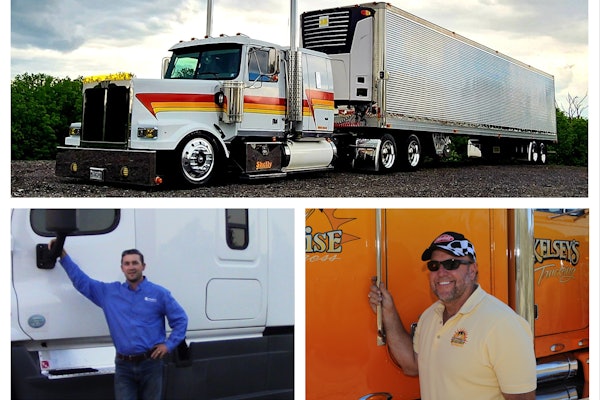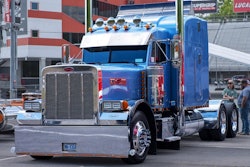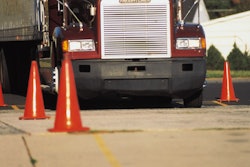Every professional driver understands the problem of complacency. The eyes and the reflexes can stop responding at optimal levels as the miles pile up. This can be a real problem in areas like highway work zones.
Mike Monseur, deputy director of public affairs for the Illinois Department of Transportation, says there were 4,000 crashes in work zones in 2001, more than 1,000 of them fatal. The number of fatalities is up 65 percent from just five years before. Twenty-two percent of those fatal crashes in work zones involved trucks.
Though you may be safe in your big rig, those around you don’t have the protection of tons of metal. About 90 percent of construction zone fatalities are motorists. Construction zone workers are involved in six times more fatalities than workers in other industries, according to J.J. Keller. Like truck drivers, who statistically have the most dangerous job in America, construction workers die in their work environment at an alarming rate.
One of the main contributing factors to the volatility of construction zones is merging. Traffic funnels from two or three lanes to one, creating a “choke point” where tempers flare and drivers are distracted by an up tick in activity that seems to come at them from all sides at once.

Dan Metcalf, a long time independent owner-operator, rates choke point aggression as the primary problem in work zones. “People continue to pass even though there are warning signs about work zones far in advance,” Metcalf says. “They create jams and make a dangerous situation even more dangerous.”
But sometimes warning signs – or the lack thereof – are part of the problem. According to J.J. Keller’s safety video, “Extreme Road Work,” the average first warning on approaching a work zone is a mere 1,500 feet, or 20 seconds at highway speeds. By the time a driver checks his mirrors for oncoming traffic, orients himself to this traffic, decides a course of action and implements that action, much of that 20 seconds is history.
Flaggers and other workers on the road in advance of the actual construction zone are particularly at risk in this situation. If you’ve been traveling too close to the vehicle in front of you, using your time and hazard-perception skills to check the total environment may bring you perilously close to that front running vehicle.
Like winter driving, where conditions change suddenly and drastically, the best plan is to stay out of situations in which survival skills and intuitive decision-making are necessary. The Keller video stresses being prepared long before encountering work zones.
Some atlases offer valuable information about work zone locations. Rand McNally updated its 2003 Motor Carriers Road Atlas to include state departments of transportation websites for information on road construction. Drivers can visit www.mcra.randmcnally.com for additional updates. Rand McNally’s RouteTools – Professional Driver Edition software (www.trucking.randmcnallly.com) can help drivers identify works zones to avoid unnecessary delays.
Routing and mapping software companies like ProMiles (www.truckmiles.com) also offers state DOT web links. Trucking website eTrucker.com also provides road updates. Also, many states, like New York, have AM highway advisory radio frequencies, according to Peter Graves, public information officer for the New York DOT.
If you are caught unaware at a choke point or in a work zone, your chance of incident increases exponentially. The inattention brought on by lack of sleep or simply by driving long hours becomes more dangerous when work zones seemingly appear out of nowhere.
When approaching construction sites, your first priority should be to slow down. Make sure there is a sufficient front cushion between your truck and the preceding vehicle.
The interior space of construction zones has its own share of hazards. Construction equipment can move into the roadway or a worker can forget his position and step a little too far toward the travel lane.
Because there is more activity in work zones, accidents tend to be more severe, with more injuries and fatalities, according to Keller’s video. It is no place to allow your emotions to control your driving behavior. “You need to be patient all the time,” says Rocky Cavins, a small fleet owner and driver. “Ohio is the worst for construction because they funnel everything down to one lane. But you have to stay patient all the way through the zone. Patience is the key to safe driving in every situation, not only in work zones.”
Traveling two seconds behind the vehicle in front at the posted speed may not be sufficient to deal with unexpected occurrences. It is most safe to remember the basic rule of driving: Road conditions must be considered when choosing a safe speed. In work zones, the safe speed may be well below the posted limit if there is a great deal of activity or there are workers close to the lane of travel. Chris Lewis, who pulls a covered wagon east of the Mississippi, says he is especially careful of workers. “You never know what they are going to do, and if you’re going a little too fast, there is nowhere to go if one steps out in front of you,” he says.
Some states ramp up their work zone safety programs in the spring every year. Illinois’ program stresses that truck drivers should burn their headlights and use flashers. In Pennsylvania, it is now a state law that vehicles burn their headlights in construction zones. “Truck drivers often don’t use their brakes but downshift instead, giving no warning they are slowing down to following vehicles,” Monseur says. Also, workers can be present at any time of the day or night, including on the weekends, so you should always adjust your speed in a construction zone, no matter the day or time.
Many states have pending legislation to upgrade laws concerning construction zone infractions. Michigan, Montana, Oregon and Washington all have pending legislation to protect workers. Reckless endangerment of workers can lead to double fines and imprisonment. Michigan’s legislation calls for a $1,000 fine and up to a year in jail. Other states are considering laws making it illegal to disobey a police officer or flagger. In Oregon the legislation includes stipulations for a maximum fine of $5,000 or a year in jail. In South Dakota, DOT employees or their agents will be able to issue citations for speeding if there are workers and posted work zone signs present.
The key to driving safely in construction zones is to maintain your situational awareness and obey posted signs, signals and workers’ directions. Awareness of your situation as you enter and pass through work zones will tell you what your speed should be and allow you to maintain a buffer zone between your vehicle and obstructions as well as other vehicles.
Negotiating the thousands of work zones you will undoubtedly encounter is a part of your job. Doing it well is simple enough, but it is also a primary responsibility the smart driver takes as seriously as backing into a skinny hole between two brand new hoods.
Work Zones Driving Tips
- If you have a laptop you can inform yourself about the location of work zones on your route. Doing so will prepare you for them well in advance. Use the state name and DOT as key words.
- Fatigue, complacency and road rage are dangerous occupational hazards. In work zones, they make matters even worse. Stay awake, alert and in control of your emotions.
- When approaching work zones, scan constantly for vehicles overtaking you. Be especially aware of cars that may have entered blind spots.
- Even if you don’t see a lot of workers, assume some are present. Slow down in all work zones even on weekends and at night.
- Speed and aggressive driving make work zones especially hazardous. In particularly crowded work areas, adjust your speed to fit the situation.
- Expect the unexpected.
- Maintain a safe following distance. Back off when cars go around you to maintain that safe distance.
- Inside the zone itself, increase your vigilance and make sure to look for troopers and workers giving traffic direction. Obey workers’ traffic direction.
- Crossovers to the opposite side of the highway can be bumpy and pitched badly. Negotiate these accordingly. A badly pitched road can cause load shifts or rollovers.
- Use your flashers.








